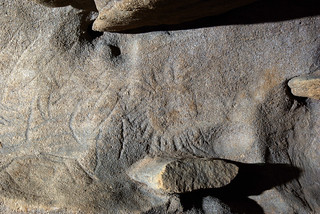How to Look for and Photograph Petroglyphs
While I am by no means the expert at either of the things this blog post is about, I know a little more than the average Joe. I provide this knowledge here to those curious, and for my own records. The information provided here is especially relevant to the southeastern United States. If you are from elsewhere you may find that not all the information I provide suits your environment, the types of petroglyphs you have, or your photography needs.
Early along in my caving career it was shared with me that some of the sites we were visiting had prehistoric records in the form of pictographs and petroglyphs. Pictographs are painted onto the wall with a medium, like charcoal, or red ochre. Petroglyphs, or glyphs, are incised marks on stone. The two are different enough to warrant separate articles on how to photograph and image. If you are interested in photographing pictographs, check out this article I wrote on the subject.
I should note that the techniques I provide here for imaging petroglyphs are also effective for discerning text on old grave markers. It is non-destructive, but should probably be done during hours where sunlight won't interfere with your photography.
What is a petroglyph?
Here's your obligatory definition grabbed directly from Wikipedia:
A petroglyph is an image created by removing part of a rock surface by incising, picking, carving, or abrading, as a form of rock art. Outside North America, scholars often use terms such as "carving", "engraving", or other descriptions of the technique to refer to such images. Petroglyphs are found worldwide, and are often associated with prehistoric peoples. The word comes from the Greek prefix petro-, from πέτρα petra meaning "stone", and γλύφω glýphō meaning "carve", and was originally coined in French as pétroglyphe.
What I often see in the field are two types of petroglyphs. One is a scratched image or writing, and the other is more deeply incised into the parent rock.
In the above two images, the glyphs are both of the sun, and even found in the same cave. The glyph on the left is a simple scratch, and the one on the right is a more time consuming carving into the rock.
Where does one find petroglyphs?
We tend to find these images along dry, flat surfaces, near the entrance of the cave just inside the dark zone, or within the twilight of the cave.
Dry surfaces are important, but as as necessary for glyphs as they are for pictographs. A pictograph will be weathered away quickly on a moist surface. A glyph may be more prone to weathering if it is on a wet surface. Remember that while a surface may not seem like it is weathering away rapidly, it doesn't have to if it has hundreds or thousands of years to work.
Flat surfaces aren't required, but obviously preferable for the same reason that you and I like to write on flat surfaces. It's easier.
How do I look for petroglyphs?

This will accentuate any irregularities in the surface of the rock. Inspect slowly the flat, dry areas near the surface of a cave or rock shelter. Be sure to also be looking for painted surfaces since one finds pictographs in the same places as one finds glyphs.
How do I photograph petroglyphs?
Individual shots





Darken

The image above uses the darken image blending mode where it displays the darkest pixel shown from the five stacked images.
Lighten

Transparency



Comments